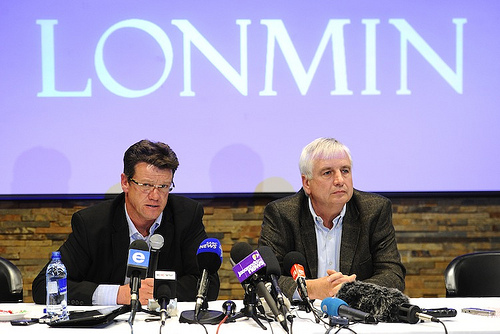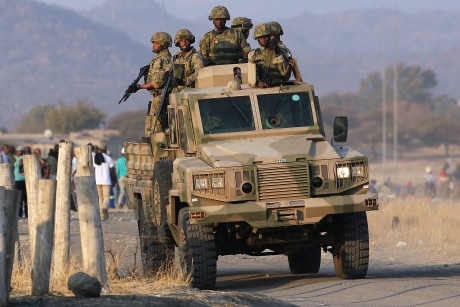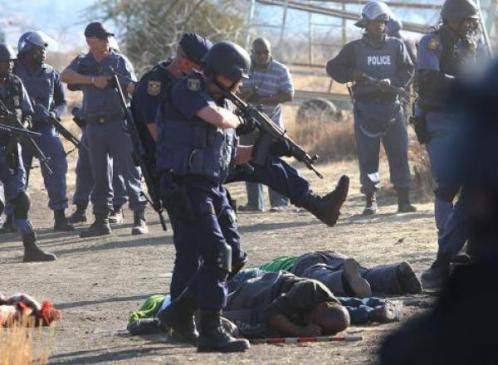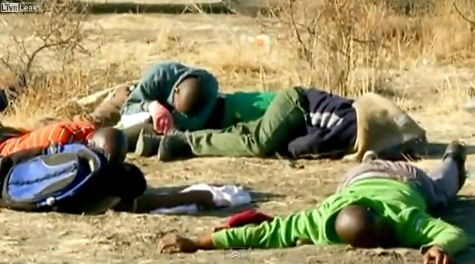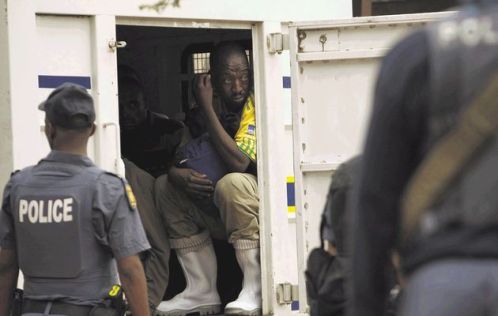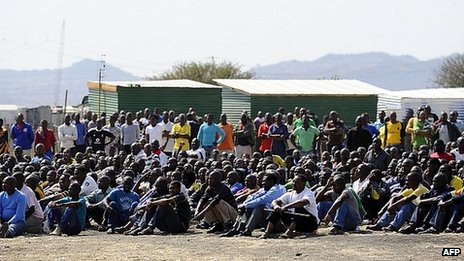|
Axis of Logic
Finding Clarity in the 21st Century Mediaplex
Africa
Post-Apartheid South Africa? The Lonmin Massacre One Year On
By T.J. Coles. Axis of Logic
Axis of Logic
Thursday, Aug 15, 2013
|
|
| Mark Munroe (L), executive vice president for mining at Lonmin, the world's third-largest platinum mining company with Lonmin chief financial officer Simon Scott attempt to defend their contribution to the miners, their families and community in a press conference on August 20, 2012, in Marikana. They argued that they've invested in the communities while residents continue to complain about contaminated water and poor sanitation. A leaked report dating back to 2006 showed that Lonmin was aware of the poverty and poor living conditions and poverty in the communities around its mines in the Bojanala area of the North West for years. The report showed that in some villages over 60% of families live on less than R400 (USD $40, GBP 6.45) per household member per month, or R13 (USD $1.31, GBP .84) a day, and that there was a dire need for food, water, sanitation and healthcare. (photo by Pan-African News Wire) |
The reporting of the Lonmin mine massacre of August last year (2012) was an interesting exercise in Western media hypocrisy. The murder of 34 miners and eight strikers by British-armed “security” forces at the London-registered mine was indeed a newsworthy tragedy. Not deemed newsworthy, however, is the much greater death-toll resulting from mining conditions and South Africa’s socioeconomic structure.
|
|
Police driving through Lonmin mine near Rustenburg, SA on Aug. 17, 2012, after the carnage. Police chief Mangwashi Victoria Phiyega says 34 miners died and another 78 were wounded when police opened fire on strikers in one of the worst police shootings in South Africa since apartheid. (Photo/Themba Hadebe)
|
|
|
| Rather than charging the police with murder, the National Prosecuting Authority charged the 259 arrested Marikana miners with the murder of their 34 colleagues, shot dead by the police.
|
A long-range UK Ministry of Defence (MoD) projection mentions that “minerals in South Africa … will attract intense interest from global extractive industries”.1 In 1993, a year before Apartheid formally ended, “the richest 10 percent of South Africans owned 53.9 percent of the country’s wealth. In 2008 the richest 10 percent owned 58.1 percent”, writes journalist, scholar, and Director of the Royal African Society, Richard Dowden.2
The Pentagon’s quest for what it calls Full Spectrum Dominance will create “a widening divide between ‘haves’ and ‘have-nots’”, to quote its Vision for 20203Likewise, the MoD study predicts that “Globalization will result in … a small super-rich elite and a substantial underclass of slum and subsistence dwellers.” Both documents—plus many others—affirm that the role of Armed Forces is to enforce the disparity.4
Citing the work of Professor Sample Terreblanche, Dowden adds that in South Africa from 1993 to 2008, “the income of the poorest 50 percent declined from 8.4 to 7.8 percent. This growing imbalance makes South Africa one of the most – if not the most – unequal society in the world”, and thus a model for what is to come.5
POST-APARTHEID APARTHEID
In modern South Africa, five million children are malnourished, which means brain-damaged. Since Apartheid formally ended, replaced by the far more effective and subtle apartheid of neoliberal economic globalisation, infant mortality has rocketed:
| “[R]esearch by Nannan et al. showed a rise
in infant mortality … from 39 per 1000 in 1992 to 56 per 1000 in 1997,”
write three scholars at the School of Public Health at the University
of the Witwatersrand. “Garrib et al. also estimated the infant mortality
ratio over the period 2000 to 2002 at 59.6 per 1000 live births.” Not
surprisingly, Blacks bear the brunt: “the incidence of infant mortality
differs widely across race groups and provinces.” The authors found that
“The differential [infant mortality rate] is also reflected in unequal
socioeconomic status … and access to services and facilities that vary
widely across the nine provinces”. |
The authors further note:
| “It is evident
that Kwazulu Natal generally remains the province with the highest
infant mortality burden, with 3 of its 11 districts having significantly
elevated infant mortality”.6 Although they refute the correlation,
the fact is that the region in question happens to be an area where
water is privatised and meters are fitted, pricing the people out of
access to one of nature’s essential elements, leading many to drink from
cholera-contaminated rivers—all to the benefit of British and French
private water companies.7 |
The dire conditions of a large, desperate, uneducated labour force are ideal for Western businesses. The Thatcherite African National Congress “has been deeply divided over economic policy, damaged by mounting official corruption and faced with growing discontent from below over its alleged [sic] failure to deliver better public services”, the British House of Commons Library reported. As we have seen, there is nothing “alleged” about the ANC’s failures.
| “Inequality between
rich and poor continues to rise, rather than fall”, as is expected in
the age of neoliberal economic globalisation, and “some union
leaderships are experiencing challenges from unhappy rank-and-file and
the number of strikes in the mining and agricultural sectors”, the
report continues. It also mentions “renewed concern over the past year
or so about the undoubtedly high levels of violence within South African
society.”8 |
As for mining, Stuckler et al. in Global Health Governance note the conscious strategy of “mine administrators [who] procured alcohol and sex workers for mineworkers as a strategy to reduce the risks of unionization or revolt”. Added to high regional migration, the authors concluded, HIV and other STDs are rampant in the country:
| “Very little has
changed over the past several decades. Recent autopsies of Black miners
in South Africa reveal very high rates of silicosis and TB
[tuberculosis] that remained undetected and untreated or poorly-treated
during life … [They document cases] rising from about 5 percent active
pulmonary TB at autopsy in 1975 to 40 percent in 2008 … Official data on
prevalence of silicosis in South Africa in 2008 [which] also showed
that one-quarter of all miners were affected—about the same as those
recorded one century ago”.9 |
As long as tens of thousands of South African Blacks are dying in silence each year in childbirth and from HIV/AIDS, silicosis, TB, diarrhoea, cholera-infected water, malnutrition, and other gifts of “progress” and “development,” the Western media are not interested. When a single tragedy occurs in Lonmin, in which several dozen lives are taken by the very forces mandated to enforce neoliberal globalisation, suddenly there is much interest, apologia, and finally diversion, such as: “Did the “security” forces really shoot first, or were they under attack?”
Notes
- Ministry of Defence (UK), “Strategic Trends Programme: 2007-2036” (3rd edition), 23 January, 2007, Swindon: MoD.
- Richard Dowden, "Lonmin-Marikana: the end of South Africa’s post-Apartheid settlement?", African Arguments, 20 August, 2012.
- US Space Command, “Vision for 2020”, February, 1997, Col: Peterson Air Force Base.
- MoD, op. cit.
- Dowden, op. cit.
- Benn KD Sartorius, Kurt Sartorius, Tobias F Chirwa and Sharon Fonn, "Infant mortality in South Africa - distribution, associations and policy implications, 2007: an ecological spatial analysis", International Journal of Health Geography, Vol. 10, No. 61, November, 2011.
- John Pilger, 2006, Freedom Next Time, London: Black Swan. Especially the chapter "Apartheid did not die."
- John Lunn, "In brief: South Africa – Zuma set for a second term in 2014", House of Commons Library, Standard Note SN06584, 15 March 2013.
- David Stuckler, Sanjay Basu, and Martin McKee, "Governance of Mining, HIV and Tuberculosis in Southern Africa", Global Health Governance, Vol. 4, No. 1, Fall, 2010.
|
|
